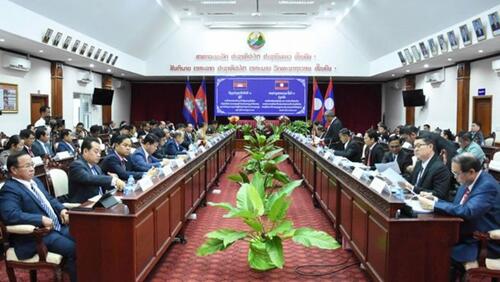Lao-Cambodian Border Talks Show Promise

Lao-Cambodian Border Talks Show Promise
On September 26, delegates from the border provinces of Stung Treng (Cambodia) and Attapeu (Laos) met to enhance bilateral cooperation along the border, according to an article in The Phnom Penh Post. The meeting focused on improving economic, public health, and security measures, as well as promoting natural resource preservation and scientific exchange. It is a step in the direction of resolving decades-old border disputes between the two nations.
The border between the two countries, which also includes the Cambodian provinces of Preah Vihear and Rattanakkiri and the Lao province of Champasak, has long been a site of contention. The Mekong River flows south from Champasak into Stung Treng; Lao dams along the river and its tributaries have raised sustainability concerns and caused floods in both nations, but they also provide both nations with a significant source of electricity. The border region has also been identified as a major site of drug and wildlife trafficking, while mosquitoes in the area are a vector of cross-border malaria transmission.

Image: A map of the Cambodia-Laos-Vietnam border area, with provinces named. Credit: Báo Chính Phủ.
The meeting comes in a year that has been marked by improved Cambodian-Lao collaboration in border demarcation. Large portions of the border, originally drawn by French colonial authorities, have historically been left undemarcated. After independence, the remoteness of the border region combined with tensions between Lao and Cambodian governments made border demarcation a low priority. The two countries have threatened military confrontations over the border as recently as 2019. At the start of this year, however, around 86% of the border had been demarcated; a treaty signed in February intends to resolve the remaining 14%. These developments are a step toward the goal of regional economic cooperation within the Cambodia-Laos-Vietnam Development Triangle Area (CLV-DTA), a de facto Vietnamese-led initiative established in 1999.
Regional cooperation and co-management of resources is proving to be critical in the era of climate change. The Mekong River Commission, consisting of delegations from the CLV countries and Thailand, predicts severe increases in salinity, floods, and droughts in coming decades. Strategies to mitigate and adapt to the impacts of climate change are necessary for ensuring continued food security and stability in the region.
Laos has completed demarcation along its borders with Vietnam, China, and Myanmar; its borders with Thailand and Cambodia still require further work to fully demarcate. Demarcation has been linked with increased intraregional investment and economic cooperation. The optimistic tone set by recent border meetings carries promise for a future of sustainable regional partnership in the CLV-DTA region.
Sources
https://www.phnompenhpost.com/national/cambodia-and-laos-fortify-border-cooperation
https://news.mongabay.com/2022/09/in-the-mekong-basin-an-unnecessary-dam-poses-an-outsized-threat/
https://www.reuters.com/article/mekong-river-cambodia/don-sahong-hydropower-dam-in-laos-connects-to-cambodian-grid-idUSL4N29D3JC
https://malariajournal.biomedcentral.com/articles/10.1186/s12936-022-04418-w
https://en.baochinhphu.vn/infographic-cambodia-laos-viet-nam-development-triangle-area-11139950.htm
https://www.jstor.org/stable/20778873?seq=11
https://laotiantimes.com/2019/08/28/laos-cambodia-to-withdraw-border-troops-tomorrow/
https://www.khmertimeskh.com/501237967/pm-to-sign-border-demarcation-treaty-during-visit-to-laos/
https://theaseanpost.com/article/what-clv-development-triangle-area
https://www.mrcmekong.org/our-work/topics/climate-change/
https://www.bangkokpost.com/world/285439/panel-agrees-to-finish-demarcation-by-2016